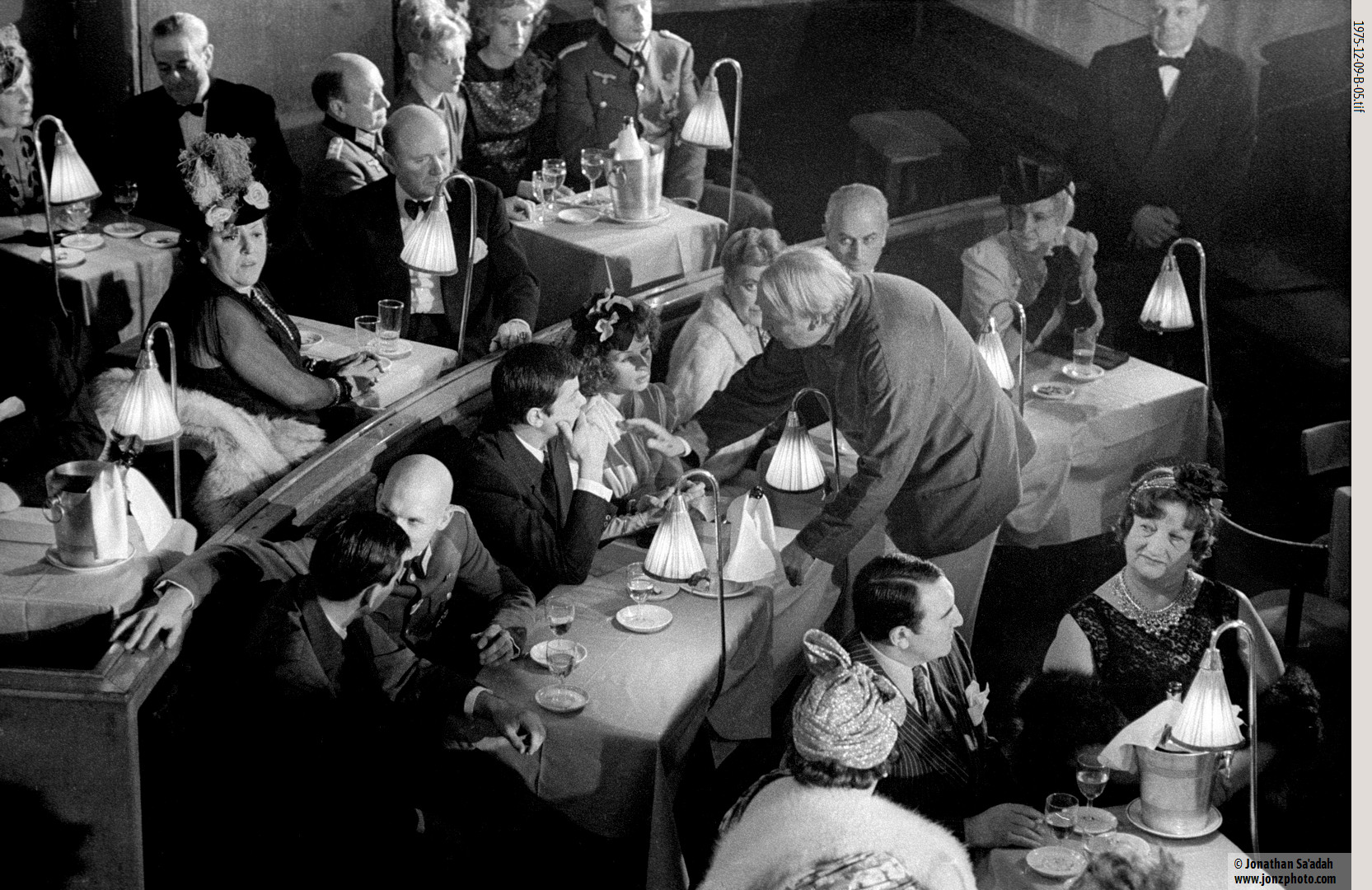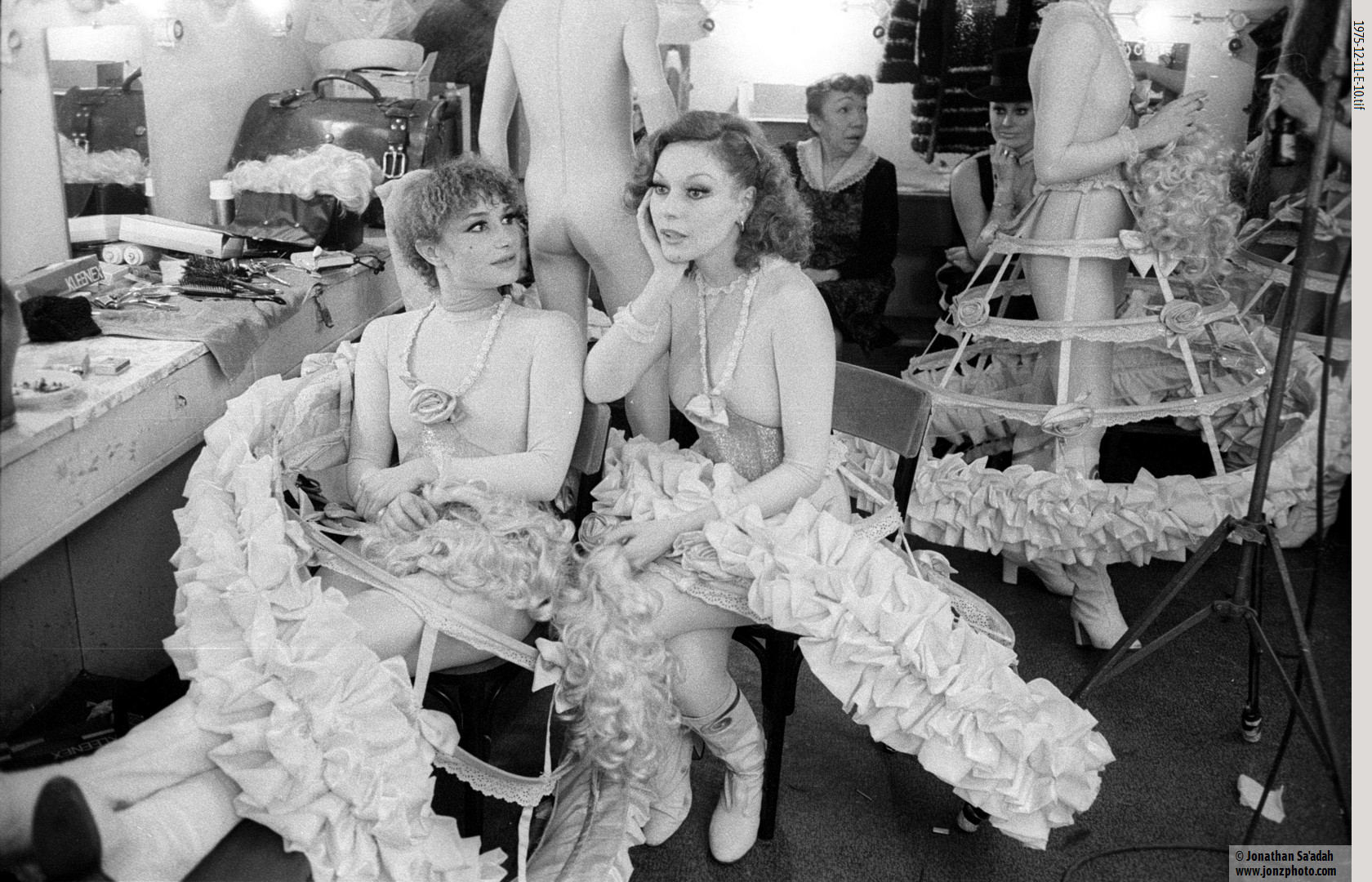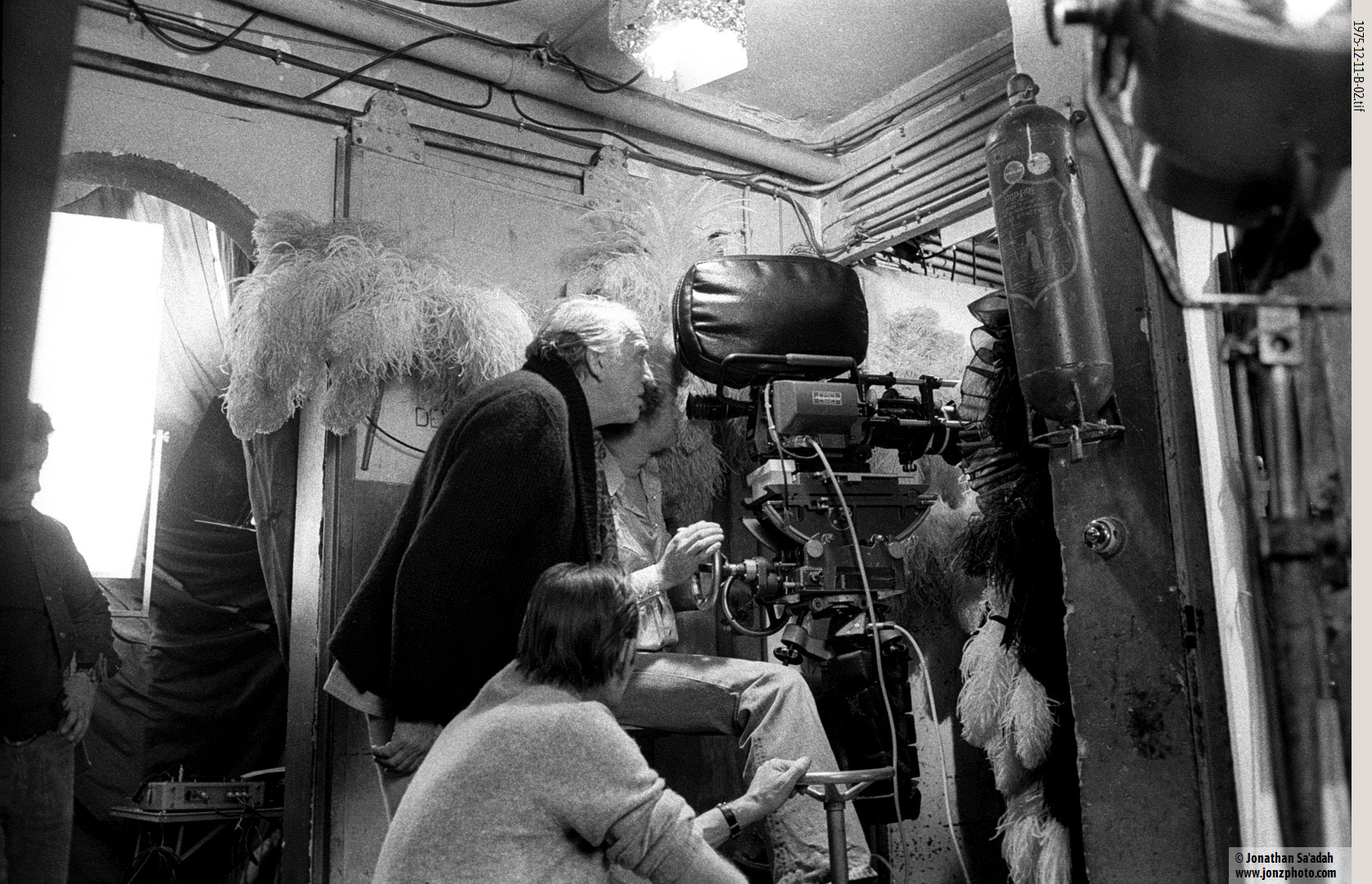
The cabaret scene in Joseph Losey’s M Klein, which occupies a full five minutes in the film, is the pivotal scene in the movie – when Klein first wakes up (with some prodding from his girlfriend) and realizes that the racist skit that he and others are mindlessly applauding in a WWII Paris cabaret is actually insulting, repulsive and sinister. The scene was drawn out as a sketch in the original screenplay but was developed in detail as Losey worked with the cabaret artist Frantz Salieri to bring into focus the violent hatred that underpins the action in this scene and the film overall. Losey created an audience of predatory scavengers to applaud and dine while watching the anti-Semitic stage show.

▲ Losey giving direction to Alain Delon and Juliet Berto surrounded by extras forming the audience at the cabaret La Nouvelle Eve. German officers are mixed with French aristocracy. The effect of the audience with the stage show was a feeling of foreboding, of predatory scavengers pretending to have a good time but playing out a hidden and evil plot.
Losey Salieri collaboration
Frantz Salieri was given the role by Joseph Losey of creating the stage show component in the film’s cabaret scene. Salieri, a multi-discipline artist working under a variety of names (Francis Savel as a painter, Dietrich de Velsa as film director), later collaborated with Losey on the film Don Giovanni. As a painter (Francis Savel) he had been the subject of an 18 minute documentary portrait (“Le Journal d’un Combat, Guy Gilles, 1964) which captured his painting process and, interestingly enough, was narrated by Alain Delon. A later work under the Dietrich de Velsa identity was his 1980 film, Équation à un inconnu (Equation to an Unknown), which was an erotic rendering of queer culture in France in the period preceding AIDS and was distinguished by his directorial vision.

▲ Multi-discipline artist Frantz Salieri adjusting the costume of the Jewish “clown” prior to filming. Losey had worked closely with the Italian screenwriter (Franco Solinas) to place this scene as the pivot point in the French Klein’s journey to meet his Jewish double.
Several years prior to the filming of M Klein Salieri created a Parisian transvestite cabaret show called “La Grande Eugène”, which performed on rue de Marignan in the 8th arrondissement in Paris and was known for its flamboyance and innovative theatrical staging. Salieri created a show that represented a radical departure from what was offered in the traditional Parisian entertainment venues, featuring transformiste performances with elaborate drag shows and sophisticated theatrical presentations. The show was the subject of a David Bailey photo essay published in London Sunday Times in 1973. The cast of “La Grande Eugène” was used as the mainstay for the cabaret show in M Klein. It’s likely that Losey had learned of Salieri’s work from the 1973 run of “La Grande Eugène” in London, and that’s what led to the connection and his collaboration in this film.[1] Losey, throughout his life, was always on the lookout for talented artists whose work he perhaps could incorporate in his film projects. Examples I knew of personally were Salieri, who he used, and also Pilobolus,[2] and jazz musician Don Cherry, both of whom he never collaborated with but followed closely.

▲ Rehearsing for the stage show Actress Magali Clément (second from right in line, in black boots, and “Lola” in the film) is practicing with professional dancers and members of La Grande Eugène during studio rehearsals that preceded filming. After mastering the moves the performers donned hoop skirts.
Losey’s concerns and background in theatrical production
In approaching the scene Losey concern was in creating content that might be attractive to racists. This concern arose because of a previous incident at La Cinémathèque française in Paris where a film festival screening wartime films had to be closed down because the anti-Semitic content attracted an audience looking for and cheering along what was shown. His goal was to find a way to stage the cabaret show in a manner that wouldn’t appeal to racists, and by using male actors to play the female roles, he was brilliantly successful in turning off racist interest.[3]

▲ La Nouvelle Eve, which still exists largely unchanged on rue Pierre-Fontaine in Paris, was a perfect, though cramped, location. Losey signaling an actor forward during shooting in the cramped quarters near the stage door.
In the script Klein tries to track down the other Klein, and in the course of this search goes looking for “Isabelle”, who he thinks is the second Klein’s girlfriend. This leads him first to the cabaret show being staged in the Parisian cabaret “La Nouvelle Eve”, and then to the stage entrance where he bribes the concierge to let him question one of the dancers. After questioning the dancer (Lola) she says that “Isabelle” is really “Cathy” and and that she doesn’t work at the Cabaret any more, but rather in a munitions factory near Metro Ballard.

▲ Dressing room “Lola” (actress Magali Clément) left, waiting for call during filming. Even when they were not being filmed the actresses and dancers gave the impression of being real cabaret performers.
Losey was adept at actual theatrical stage managing, with many credits during his American career. He was, for example, the stage managing the 1946 Academy Awards, so he knew how to create dynamic flow and excitement. He was good at timing pieces to come together and create energy, and he worked with Salieri to that end.
But there were challenges to the shooting at La Nouvelle Eve.
Issues in working on location
It was technically difficult to work in the cramped, narrow corridors of the location. As a result cinematographer used the 35 mm camera both shoulder-held and on a crab dolly, both of which were difficult and took a lot of skill and strength under these conditions. Klein is first seen questioning the concierge. The camera is on a hydraulic stand (shown in the photographs) for that shot, but then is shoulder-held in the stairwell, and all the shots flowed together seamlessly. Gerry Fisher, the Cinematographer, had set up the lighting to work with almost no space.

▲ Losey peers over the shoulder of the camera operator (Pierre-William Glenn) while the grip holds on to the hydraulic stand, which barely fits in the hallway. There’s a large diffuser in the doorway at the left and behind it the table where the sound-man is working.
The two sequences that make up the cabaret scene were shot first for the stage show in the cabaret La Nouvelle Eve on December 9th and 10th, and then the stage entrance scene was filmed at the same location on December 11th.

▲ Actual filming of the cabaret scene, Cinematographer Gerry Fisher is operating the camera on the right, filming spontaneous reaction shots from the audience which were then edited into the footage of the performance.
The results of the Salieri-Losey collaboration show camera and actor movement tied together skillfully. The result was the creation of the two memorable central scenes in the movie.
It’s also my only ever appearance in a feature movie. I was actually at my perch taking the photo above and got through editing unnoticed. It’s the third shot of the cabaret performance sequence (2:03:27).

✚ Other related posts:
Joseph Losey’s film M Klein: A behind-the-scenes look
Exploring location shooting in Joseph Losey’s M Klein
Homage to Margot Capelier, Casting Director
Sign up to get future posts on M Klein and other subjects …
[1] Le Monde. 1986. Frantz Salieri, May 3, 1986.
[2] Salieri’s conceptions and imaginative costume design were more radically stylized but recalled for me the costumes Pilobolus used (for instance, the “Tall Ladies” in the dance “Untitled”) in the same period.
[3] Losey, Joseph, and Michel Ciment. 1985. Conversations with Losey. London ; New York: Methuen. Pages 347-348.
Leave a Reply